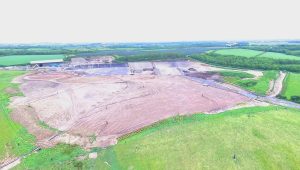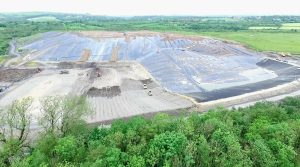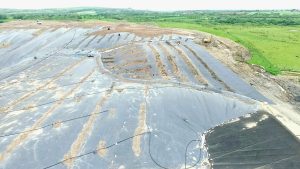In the Autumn of 2023 RML anticipated the availability of void space becoming available in Cell 8 for continued waste disposal activities. Due to construction delays the void space was not available for disposal until late December 2023 and accordingly wastes were stored during the interim period on top of the cell that was active at the time (Cell 7). Wastes were deposited between October 2023 and January 2024 and were subsequently moved into Cell 8 in Jan and Feb 2024, allowing Cell 7 to be capped.
Odour complaints from the community around the site commenced in October 2023 and continued through the autumn. The odours were linked to the emission of landfill gas from the site containing hydrogen sulphide, a particularly smelly gas even at low concentrations. The production of landfill gas is ordinarily a relatively slow process, so it was thought likely that the odour originated in older deeper wastes; accordingly, NRW issued a Regulation 36 Notice requiring Cell 7 to be taken down to its final levels and capped in a short time period. The expectation at the time was that the deeper wastes would be contained by the cap and the gas collection system would draw off the gas and destroy it in the engines or flare.
After the removal of the stored wastes and the installation of a capping scheme and gas collection system on Cell 7 in early March 2024, the first indications emerged that Cell 8 was now producing hydrogen sulphide gas. This was unexpected, as the waste was all less than 6 months old and comprised conventional wastes that usually do not produce hydrogen sulphide gas in great concentration, or landfill gas in very short time periods. It appears that the wastes deposited originally within and on top of Cell 7 had a composition that resulted in the rapid production of landfill gas and hydrogen sulphide., The only option to contain the gas and mitigate the odour was to cap Cell 8 even though it was only partly filled.
NRW served a second Regulation36 Notice requiring capping works and gas collection systems to be installed on parts of Cell 8 but RML took the decision to cease waste inputs and to cap the entire cell. Over the coming months (and possibly longer) RML will monitor gas composition within Cells 7 and 8, along with other previous cells. Only when the gas composition reveals that it is safe to do so, will the temporary cap be incrementally peeled back to allow Cell 8 to be filled to its final levels before being permanently capped. It is expected that Cell 8 will be out of use for some time before conditions are right for the cell to be completed.
With Cell 8 out of use, Cell 9 is under construction. Cell 9, however, cannot accept wastes until those wastes that caused the rapid gassing along with hydrogen sulphide production are identified and prevented from entering the site. The chemistry of the incoming wastes has been examined to find substances that can combine to cause the problem, and a number of candidates have been identified. More may yet be identified. These wastes comprise only a small proportion of the wastes disposed of at the site but we are confident, having investigated matters, they are responsible for the issues seen. The bulk of the wastes appear to be free of contamination with the substances that give rise to hydrogen sulphide. Nevertheless, only when the company and the relevant statutory Regulators are content that the site can operate without a repeat of the previous issues will disposal activities commence in Cell 9.
Cell 9 will only accept wastes that have been screened and tested for constituents that produce hydrogen sulphide. Waste acceptance procedures will be agreed with NRW to ensure that robust exclusion methods are applied at the site. As well as carefully inspecting and testing incoming loads, Cell 9 will also be filled differently and monitored very closely to provide confidence that the waste mass is not generating and emitting unacceptable levels of landfill gas. The cell will be developed with inbuilt gas collection systems and pathways for gas to escape and will be designed out to ensure full containment. The facility to completely cover the wastes and activate effective gas extraction will be standing-by, on site, so that should the early signs be identified in the site monitoring, effective intervention can be immediate.
RML operated the site from March 2022 until autumn 2023 without complaints. It intends to operate the site for its remaining life on that basis and will continue to strive to do so.



